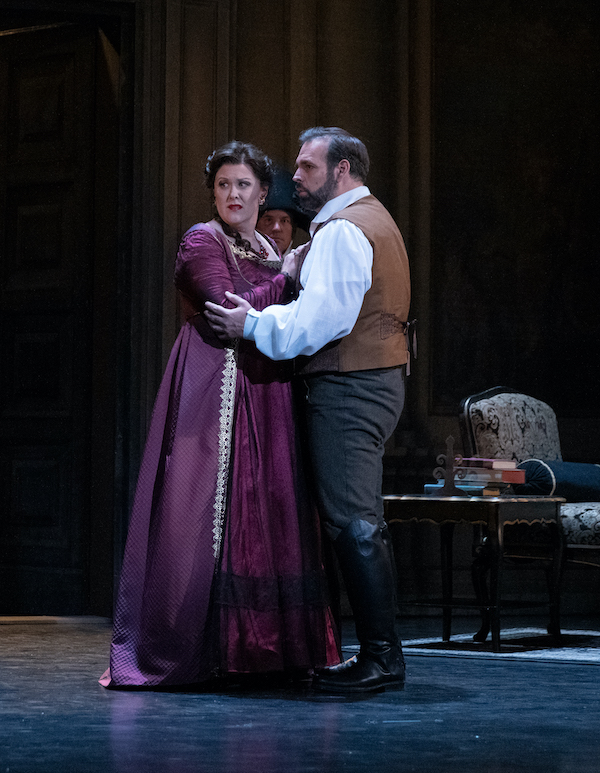Utah Opera hits the Puccini heights with a vibrant “Tosca”
Rarely does a tragedy feel as triumphant as Puccini’s Tosca. Although the couple we’re rooting for dies in the end, they die heroically, after vanquishing the story’s villain and glorying in their love for one another. Their story is told at the brisk pace of an episode of Law and Order and is underscored by beautiful melodies over lush, full orchestrations.
Utah Opera’s vibrant, faithful production, which opened Saturday, was the high point of the company’s current season.
As Tosca and her lover Mario Cavaradossi, Katie Van Kooten and Dimitri Pittas, made a winning couple. In their first scene together, Tosca comes to visit Cavaradossi at the Church of Sant’ Andrea della Valle where he is working on a painting of Mary Magdalene. Tosca becomes jealous when she realizes the model for the painting is woman she knows, and Cavaradossi lovingly reassures her that Tosca is the only woman he loves. The couples’ banter is the stuff of romantic comedy, and Pittas and Van Kooten drew laughs from the audience as they delivered the lines from their duet. Their chemistry was genuine as they flirted, embraced, and kissed.
Pittas’s clear, powerful tenor rose effortlessly above Puccini’s full orchestration, and his bearing and movements helped create a likable and engaging character. Cavaradossi’s first aria, “Recondita Armonia”, is an artist’s ode to female beauty, and Pittas delivered it with a mellow, naturalistic tone and a sense of joie de vie. The joy Pittas brought to the character made Cavaradossi’s farewell to life in the aria “E lucevan le stelle” all the more heartbreaking, and Pittas imbued it with passion and musicality.
With a rich, warm voice and charismatic stage presence, Van Kooten brought Tosca to life. She played Tosca’s jealousy as an endearing quirk, stemming from her insecurity as a famous performer in the public eye. The humanity Van Kooten gave the heroine made the steely resolve she displayed at the end more impressive and admirable.
Tosca steels herself in the “Vissi d’ arte” the most famous aria from the opera. Occurring after the corrupt police chief Scarpia has promised to free Cavaradossi if Tosca gives herself to him, it is Tosca’s prayer to a God that has seemed to abandon her. Van Kooten sang it from her soul. Her tone was pure and gently pleading as her full voice glided over Puccini’s sweet melody. With stunning musicality, she communicated Tosca’s anguish and vulnerability and held the audience spellbound.
Because “Vissi d’ arte” is one of the few times in the plot-heavy opera where the action stands still, different directors handle it in different ways. Some find some business for Scarpia to attend to, either on or offstage, while Tosca deliberates. Omer Ben Seadia, who directed the Utah Opera production, chose to have time stand still during the aria, putting her faith in Van Kooten to draw the audience’s attention, as Scarpia sat silently at the dining table in his ornate, well-appointed office. This was of many excellent choices Ben Seadia made that kept the opera true to the plot and its gritty Verismo roots. Characters’ movements were natural and motivated by their needs and wants in the moment.
This was particularly effective in Stephen Powell’s portrayal of Scarpia. While some actors playing Scarpia feel the need to strut across the stage and gesticulate, Powell found power in stillness. In his first entrance, he moved slowly, walking with the aid of a cane, and was too absorbed in processing the clues and hatching his diabolical scheme to preen or strut. Powell’s Scarpia did not even crack a smile as he mused how he would use the Marchesa Attavanti’s fan as Iago had used the handkerchief in Othello. Powell played his character’s subsequent interactions with Tosca—where he inflames her jealousy—as calculating and precise.
Powell showed more emotion in Act II, and it was terrifying. He made it clear Scarpia’s only pleasure was in conquest and his only passion was in putting down those who defied him. It was particularly chilling as he shouts to his henchman to continue torturing Cavaradossi so Tosca could hear the screams.
Throughout the opera Powell’s dark, full-bodied baritone proved the perfect instrument, embodying effective, bureaucratic villainy. It was especially effective in the two times it served as counterpoint to a church chorus—in Act I when he rehearsed his plans over the “Te Deum” and in Act II, when he reveled in his power over Tosca’s off-stage cantata. Such moments appear to show the anti-clerical sentiment of Puccini and his librettists, as the church collaborates with Scarpia’s corruption. In this production, they were chillingly effective.
Adding to the effectiveness of all the action on stage was the first-rate playing of the Utah Symphony in the pit under the baton of Steven White, who brought sensitivity and refinement to Puccini’s lush strings, diverse orchestral textures, and late-Romantic harmonies. White’s exquisite phrasing and free tempi served the drama, and he displayed a sense of melodrama in key moments of the opera, accenting some with sharper articulation or increased vibrato in the strings.
The Seattle Opera sets ingeniously evoked the Opera’s three Rome settings—the Church of Sant’ Andrea della Valle, the Palazzo Farnese and the Castel Sant’ Angelo—through a combination of scrims and actual set pieces. The rococo furniture Scarpio’s office just off the Palazzo Farnese matched the architectural style of the other set pieces as well as his power and position.
Tosca continues through March 20. utahopera.org
